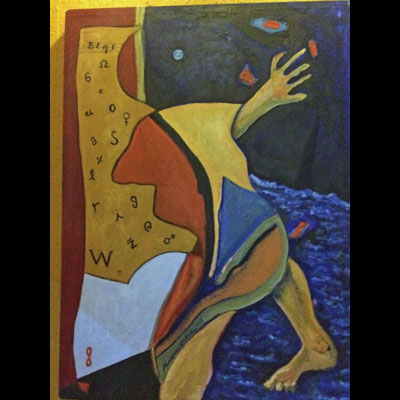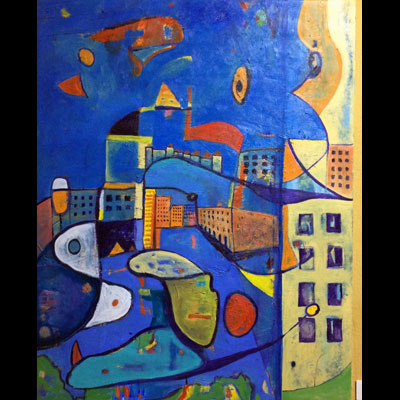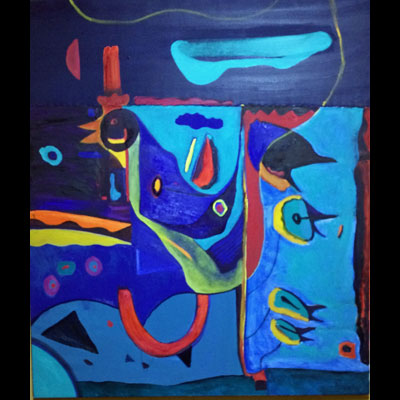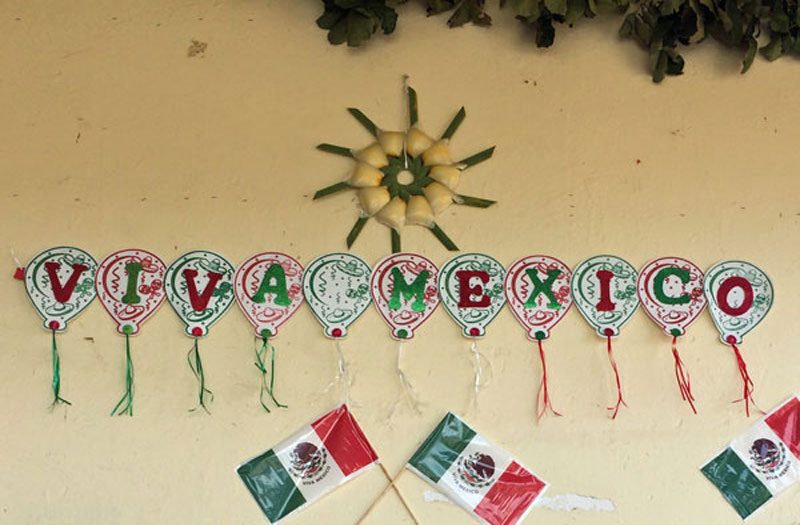No one remembers how it started. It was some silly little thing like the color of the water at Las Canteras. He said it was green. She said it was blue. Something like that.
Things now were totally out of control. She insulted his mother. He called her sister a whore. Around the house everything was in disarray. People stopped walking by because objects would fly out the window. Shoes. Pictures in glass frames. Vases, candelabras, even life-size Catrinas—those crazy mixed up skeleton people. It was dangerous. You could lose an eye or have your head bashed in.

Hermann Orduna, oil on canvas, see bio below
For a short time friends tried to negotiate a peace but it was useless. The only thing the two agreed upon was that there was never to be a peace. Yet they still lived together and even would combine forces to beat up on their friends if their friends interfered. So, people stopped trying.
They were both in politics. Different parties of course, but that was never a hindrance to a healthy relationship. Members would cross over to fuck all the time but no more. Now it was all about the argument, that silly little argument that no one could remember how it started. The birth rate plummeted. The town became a ghost town.
It was impossible to go out to a restaurant. Everyone took sides. The waiters wouldn’t serve you if you were on the wrong side. Even the town bar, Carolita’s, where almost every relationship in town was first kindled shriveled like the tits of an old witch. Paco, the bartender, ended up going crazy on account of having no one to talk to other than himself with whom he argued incessantly.
Business slowed to a trickle. There used to be people that came from all around but that stopped when they started asking questions like “Whose side are you on?” or “Are you coming to join him or her?
Some of the neighboring towns made attempts to step in and resolve things. They gave up when they found they had to negotiate separately with him and with her and that reconciliation was no longer the option it had been previously.
The worst of it was when lies and deception took over. It became impossible to determine the truth. Opinions and facts diverged and opinions won out because everyone had one and wore it so close to the vest that it was the only thing they could trust.
Things went on like this for some time, for quite some time. The few people who didn’t leave said they would have to wait until one of the two arguers died or maybe until both died and then things would return to normal.
If you chanced to visit the town because perhaps you lost your way, you could hear people yelling back and forth out the windows of their houses: “Either of them die yet?”

Hermann Orduna, oil on canvas, see bio below
“No,” was always the answer.
Eventually everything got really mixed up. Numbers, letters, body parts, shapes, colors. So mixed up that it was impossible to have memories. So mixed up that it was impossible to argue.

Hermann Orduna, oil on canvas, bio see below
And that’s the fix the faithful were waiting for. Even if they didn’t know it, they could feel it. Romance was back in the air. Paco’s sanity returned and he was back at the bar pouring cheap booze at high prices. Children were scurrying after the balloon vendor in the streets.
Then, there was that one moment when everyone held his breath.
He came into the bar with her.
You could hear a pin drop but no one dropped a pin.
“Remember the water at Las Canteras? What color was it anyway?”
“Gee, I don’t remember, don’t you?”
“Nope.”
Paco poured them drinks and everything was back to normal again.
NOTE: The original artwork of Hermann Orduna was photographed at La Biznaga restaurant in Oaxaca, September, 2018
Hermann Orduna
(Mexico 1977)
Born in Mexico City on 26th of December 1977. Since childhood he’s been interested in art and in 1989 he entered CEDART (Center of Art Studies) of INBA (National Institute of Fine Arts) in Michoacan (Mexico). In 1990 he continued attending the same institution in Oaxaca City, a cradle of great masters of Mexican art.
He started studies on the faculty of architecture in Oaxaca and afterwards in 1999 he moved again to Mexico City to enter the National School of Fine Arts of UNAM. In 2000 he specialized in graphic arts on the University of Guanajuato, studying different techniques of etching and lithography. In 2002 he participated in courses held by masters of Oaxaca graphic in the workshop of Rufino Tamayo in Oaxaca City.
In 2002-2012 he lived in Barcelona, cooperated with several galleries in the city and exposed in different places in Barcelona. In 2008 – with the help of Francisco Garnica, Albert Plaza and Juan Alcazar – he founded an etching workshop and art gallery “La Rueda” where during a year and a half were organized workshops, art exhibitions and other cultural events.
Now he lives in Palma de Mallorca and creates many of his pieces in the etching workshop of the Circle of Fine Arts of this city. In his artistic career he exposed in different cities of Mexico and Europe, amongst others in Madrid, Sofia, Vienna, Frankfurt am Main and Warsaw – the last three in cooperation with the Ministry of Foreign Affairs of Mexico.


Bravo!!! My parents never resolved their argument about whether that color was green or blue.
unarguably, this is a mixed blessing you give, but who am i to disagree; this is simple brilliant, my favorite kind of shine on thorny topics; and so damn pertinent! thank you. p.s. – i used to never like ‘normal’, but now i sometimes do…..frightening.